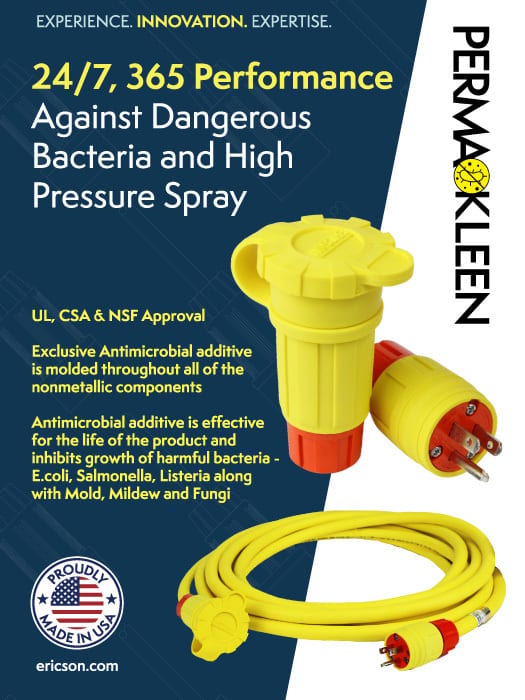PROCESS CONTROL
By Michael Ablan, M.P.H., Health Scientist, Center for Emerging and Zoonotic Infectious Diseases (NCEZID), Centers for Disease Control and Prevention (CDC); Misha Robyn, D.V.M., Epidemiologist, NCEZID, CDC; and Katherine E. Marshall, M.P.H., Epidemiologist, NCEZID, CDC
Exploring Consumer Knowledge, Attitudes, and Practices Around Food Irradiation, and Possible Impact on Foodborne Illness
Consumer acceptance is a widely discussed barrier to adoption of food irradiation in the U.S.

Image credit: Dmytro Donets/iStock/Getty Images Plus via Getty Images
SCROLL DOWN
Foodborne illness continues to be a substantial public health problem, causing an estimated 48 million illnesses, 128,000 hospitalizations, and 3,000 deaths each year.1 Large foodborne outbreaks, like the 2018 outbreaks of E. coli O157 infections linked to romaine lettuce2 and the 2016–2018 outbreaks of Salmonella Newport infections linked to ground beef (and the massive recalls associated with them),3,4,5 highlight the need for better tools to prevent large outbreaks.
While exploring opportunities to prevent outbreaks, the U.S. Centers for Disease Control and Prevention (CDC) identified food irradiation as an underutilized but effective intervention that could help reduce and prevent foodborne illness. Food irradiation is a technology that treats food with ionizing radiation to improve microbial safety, extend shelf life, and control insects. Gamma ray, X-ray, and electron beam are three sources of radiation approved for use on foods where, like pasteurization, energy is applied to reduce or eliminate microorganisms and insects.6 Food irradiation has been studied since the early 1900s, has been determined to be safe and effective,7 and is endorsed by national and international organizations (including CDC, the U.S. Food and Drug Administration [FDA], the U.S. Department of Agriculture [USDA], and the World Health Organization [WHO]).
In the early 2000s, consumer groups expressed concern about the use of this intervention, and companies have cited consumer acceptance as a barrier to wider use. Some of these concerns related to the source of radiation. Historically, food irradiation has relied on gamma rays as the primary source of radiation, which involves the use of radioactive isotopes like cobalt-60. Some challenges include the inability to turn off the radiation and acquiring, shipping, storing, and disposing of the isotopes,8 in addition to security and occupational health concerns. Today, non-radioactive radiation sources are increasingly being explored for food applications.
In this article, CDC characterizes the current landscape around consumer knowledge, attitudes, and practices related to food irradiation, and explores the potential impact of this technology on reduction of foodborne illness.
Consumer Knowledge, Attitudes, and Practices
Consumer acceptance is a widely discussed barrier to adoption of food irradiation in the U.S. There are multiple factors that influence a consumer's decision to purchase irradiated foods (e.g., knowledge about food irradiation9,10,11) or avoid purchasing irradiated foods (e.g., consumer attitudes12,13). However, most of this research was conducted in the early 2000s. Since then, consumer confidence in food safety14 has decreased while irradiation technology8 has advanced. CDC conducted three projects to examine factors that influence consumers' decisions to purchase irradiated foods.
Project 1: Consumer Focus Groups
The first project, conducted in March 2021, was a series of focus groups that examined consumer knowledge, attitudes, and practices toward irradiation as a food safety intervention and identified barriers and facilitators to purchasing irradiated food.15 Overall, knowledge levels about food irradiation were low, although participants 65 years of age or older were more knowledgeable than younger participants. Reasons that participants provided for purchasing irradiated foods included protection from foodborne illness generally; reduced risk of illness from certain foods, such as leafy greens and ground beef; and endorsement from public health agencies. Barriers to purchasing irradiated foods included a lack of familiarity with food irradiation, general safety concerns related to the irradiation process, price and packaging of irradiated foods, and a general distrust in food technology.
Despite a lack of knowledge about food irradiation, support from public health agencies (e.g., CDC, FDA) and education efforts focusing on how it works and its effect on foodborne pathogens could help fill these gaps in knowledge. Federal support and greater education could also provide the information consumers need to make informed purchasing decisions. However, at least two potential barriers were identified that would not be addressed through education: possible increases in product prices from the cost of adding a processing step, and the fact that irradiated products cannot be labeled as organic. Both of these factors could influence consumers' purchasing decisions.
“In the second project survey, 56 percent of respondents aged 65 and older disagreed with the myth 'irradiation makes food radioactive,' which was significantly higher than all other age groups combined…”

Project 2: Consumer Demographics Survey
The second project, conducted in August 2022, was a survey exploring the relationship between consumer's demographic characteristics and their knowledge, attitudes, and beliefs toward food irradiation.16 The findings from this survey identified that more knowledge about the benefits of food irradiation would influence consumers' decisions to purchase irradiated foods. Older adults (≥ 65) were more knowledgeable about irradiation compared to other age groups.
This project assessed the food irradiation knowledge of respondents familiar with the technology by determining the level of agreement they had with irradiation facts and disagreement with irradiation myths. For example, 56 percent of respondents aged 65 and older disagreed with the myth "irradiation makes food radioactive," which was significantly higher than all other age groups combined (28 percent). This suggests that younger age groups could benefit from educational efforts about irradiation, but other factors (e.g. motivating factors, attitudes and beliefs, and preference for receiving information) should also be considered.
Project 3: Consumer Risk Perception Survey
The last project, conducted in October 2022, was a survey exploring consumer risk perception of contamination of ground beef, chicken, and leafy greens with pathogens and its potential influence on purchasing irradiated versions of these foods.17 Results from this survey showed that among respondents familiar with food irradiation, a significantly higher proportion of those who believed ground beef and leafy greens were likely contaminated also indicated that they were likely to consider purchasing irradiated ground beef (56 percent vs. 35 percent) and leafy greens (61 percent vs. 36 percent) compared with those who did not believe these foods were likely contaminated. This suggests that perception of contamination with pathogens is a motivating factor for purchasing irradiated ground beef and leafy greens. However, this pattern was not observed for chicken (59 percent vs. 45 percent). This could be related to the fact that chicken is not typically consumed raw, and consumers may feel confident that they can fully cook chicken to eliminate any microbial risk.
This project also examined whether those who intentionally consume undercooked meat dishes (e.g., undercooked hamburgers, kitfo, and kibbeh) would consider purchasing irradiated versions of those dishes. Analysis was limited to respondents who were familiar with food irradiation. Among those respondents, about 62 percent who also reported sometimes eating undercooked hamburgers indicated that they would buy irradiated ground beef for that purpose. Similarly, about 65 percent of respondents who were familiar with food irradiation and reported sometimes eating traditional raw meat dishes indicated that they would buy irradiated meat for those dishes. These findings suggest that people who eat these foods might be interested in buying irradiated versions, which could help reduce risk for foodborne illness. Making irradiated versions of these foods available could provide safer alternatives to prepare and consume culturally important or traditional foods, or to accommodate food preferences.
While consumer acceptance is a widely discussed barrier that has limited adoption of food irradiation in the U.S., CDC's work in this area demonstrates that the topic may be more nuanced. Consumer acceptance of food irradiation likely lies on a spectrum. These projects explored multiple factors—such as knowledge about food irradiation, reduced risk from certain foods, and protection from foodborne illness—that influence a person's decision to purchase irradiated foods. These projects build upon previous work that suggests U.S. consumers are generally unfamiliar with food irradiation. Educational efforts, with emphasis on how food irradiation works and its effect on foodborne pathogens, could help fill these gaps in knowledge and provide the information consumers need to make informed purchasing decisions. This type of educational effort could be tailored to consumers who prioritize food safety, people at higher risk for severe foodborne illness, people who eat foods that have been frequently linked to outbreaks, and people who prefer to eat meals with undercooked or raw ground meats.
“It has been estimated that irradiating 50 percent of meat and poultry in the U.S. could prevent an estimated 853,000 cases of Salmonella, Campylobacter, and E. coli O157 infections; 7,300 hospitalizations; and 185 deaths per year.”

Public Health Impact of Food Irradiation
Food irradiation could make a substantial public health impact through the reduction of foodborne illness. It has been estimated that irradiating 50 percent of meat and poultry in the U.S. could prevent an estimated 853,000 cases of Salmonella, Campylobacter, and Escherichia coli O157 infections; 7,300 hospitalizations; and 185 deaths per year.18 CDC conducted two recent projects to further examine the potential public health impact of food irradiation.
Project 1: Simulation Model Comparisons
The first project was described in a published peer-reviewed article in March 2024. It encompassed a simulation model using 2014 estimates of the burden of foodborne illness and 2020 food attribution data that examined the effect of ground beef irradiation on illnesses, hospitalizations, deaths, and direct healthcare costs from ground beef-associated E. coli O157 and Salmonella illnesses in the U.S.19 The model estimated that irradiating 50 percent of the currently unirradiated ground beef supply would prevent 3,285 E. coli O157 illnesses, 135 hospitalizations, 197 hemolytic uremic syndrome cases, and 2 deaths. It would also prevent $2,972,656 in direct healthcare costs annually. For Salmonella, these numbers were 20,308 illnesses, 400 hospitalizations, 6 deaths, and $7,318,632 in direct healthcare costs.
The article further discusses how a focused approach to irradiation—such as for ground beef products that are more likely to be contaminated, eaten undercooked or raw, or served to people at higher risk for severe health outcomes—could potentially increase public health impact while decreasing the total amount of ground beef that is irradiated. However, additional cost‐effectiveness studies are needed to better understand feasibility and impact.
Project 2: Opportunities for Prevention
The second project, described in a peer-reviewed article published in June 2024, examined Campylobacter, Salmonella, E. coli, and Listeria monocytogenes outbreaks from 2009 to 2020 linked to foods eligible for irradiation (for the purpose of microorganism control).20 The analysis identified 482 foodborne outbreaks during this timeframe, with 155 (32.2 percent) linked to an irradiation-eligible food. These outbreaks resulted in 3,512 illnesses, 463 hospitalizations, and 10 deaths. The most common food sources were chicken, beef, and eggs. Of these 155 outbreaks linked to irradiation-eligible foods, none were known to be irradiated. This suggests there is an opportunity to prevent outbreaks and illnesses through use of irradiation in foods already approved for use by FDA.
Conclusion
Food irradiation has the potential to reduce foodborne illness. A targeted approach toward specific foods that have frequently been linked to outbreaks, including meat products consumed raw or undercooked, or foods that are served to populations at higher risk for severe health outcomes, could help reduce the risk of foodborne illness and expand options for consumers. Consumer acceptance is often cited as a barrier to the adoption of food irradiation; however, these analyses suggest that some consumers may be interested in purchasing irradiated foods to help reduce risk from certain foods and to help protect them from foodborne illness generally.
CDC will continue to explore consumer knowledge, attitudes, and practices around food irradiation, as well as its contributions to reducing foodborne illness.
Note
The findings and conclusions of this report are those of the authors and do not necessarily represent the official position of the Centers for Disease Control and Prevention (CDC).
References
- Centers for Disease Control and Prevention (CDC). "Burden of Foodborne Illness: Findings." 2018. https://www.cdc.gov/food-safety/php/data-research/foodborne-illness-burden/.
- Marshall, K.E., A. Hexemer, S.L. Seelman, et al. "Lessons Learned from a Decade of Investigations of Shiga Toxin-Producing Escherichia coli Outbreaks Linked to Leafy Greens, United States and Canada." Emerging Infectious Diseases 26, no. 10 (2020): 2319–2328. https://doi.org/10.3201/eid2610.191418.
- Canning, M., M.G. Birhane, D. Dewey-Mattia, et al. "Salmonella Outbreaks Linked to Beef, United States, 2012–2019." Journal of Food Protection 86, no. 5 (2023): 100071. https://doi.org/10.1016/j.jfp.2023.100071.
- Marshall, K.E., M. Tewell, S. Tecle, et al. "Protracted Outbreak of Salmonella Newport Infections Linked to Ground Beef: Possible Role of Dairy Cows—21 States, 2016–2017." Morbidity and Mortality Weekly Report 67 (2018): 443–446. http://dx.doi.org/10.15585/mmwr.mm6715a2.
- CDC. "2018 Salmonella Infections Linked to Ground Beef." 2019. https://archive.cdc.gov/www_cdc_gov/salmonella/newport-10-18/index.html.
- U.S. Food and Drug Administration (FDA). "Food Irradiation: What You Need to Know." 2022. https://www.fda.gov/food/buy-store-serve-safe-food/food-irradiation-what-you-need-know.
- World Health Organization (WHO). "High-Dose Irradiation: Wholesomeness of Food Irradiated with Doses Above 10 kGy—Report of a Joint FAO/IAEA/WHO Study Group." Food and Agriculture Organization and World Health Organization, Geneva, Switzerland. 1999.
- Pillai, S.D., and S.S. Bhatia. "Electron Beam Technology: A Platform for Safe, Fresh, and Chemical-Free Food." 2018. https://www.food-safety.com/articles/5791-electron-beam-technology-a-platform-for-safe-fresh-and-chemical-free-food#:~:text=The%20food%20industry%20has%20a,increasing%20exponentially%20(Figure%201).
- Nayga, R.M., W. Aiew, and J.P. Nichols. "Information Effects on Consumers' Willingness to Purchase Irradiated Food Products." Review of Agricultural Economics 27, no. 1 (2005): 37–48. https://www.jstor.org/stable/3700777.
- Fox, J.A., D.J. Hayes, and J.F. Shogren. "Consumer Preferences for Food Irradiation: How Favorable and Unfavorable Descriptions Affect Preferences for Irradiated Pork in Experimental Auctions." Journal of Risk and Uncertainty 24, no. 1 (2002): 75–95. https://www.jstor.org/stable/41761057.
- Eustice, R. and C. Bruhn. "Chapter 5: Consumer Acceptance and Marketing of Irradiated Foods." Food Irradiation Research and Technology. Wiley, 2007. 10.1002/9780470277638.ch5.
- Teisl, M.F., S.B. Fein, and A.S. Levy. "Information Effects on Consumer Attitudes Toward Three Food Technologies: Organic Production, Biotechnology, and Irradiation. Food Quality and Preference 20, no. 8 (2009): 586–596. https://doi.org/10.1016/j.foodqual.2009.07.001.
- Parrella, J.A., H.R. Leggette, P. Lu, G. Wingenbach, M. Baker, and E. Murano. "Evaluating Factors Explaining U.S. Consumers' Behavioral Intentions Toward Irradiated Ground Beef." Foods 12, no. 17 (2023): 3146. https://doi.org/10.3390/foods12173146.
- Yi, R. "Trust in Government Assurance of Food Safety Hits Record Low." Gallup. September 6, 2024. https://news.gallup.com/poll/650024/trust-government-assurance-food-safety-hits-record-low.aspx.
- Ablan, M., M.S.F. Low, K.E. Marshall, et al. "Focus Groups Exploring U.S. Adults' Knowledge, Attitudes, and Practices Related to Irradiation as a Food Safety Intervention, 2021." Food Protection Trends 43, no. 6 (2023): 448–456.
- Crawford, T.N., M. Ablan, M. Canning, K.E. Marshall, and M. Robyn. "Examining Age and Food Irradiation Knowledge as Influential Factors on Purchase of Irradiated Foods—United States, August 2022." Food Protection Trends 44, no. 3 (2024): 189–194.
- Ablan, M., T.N. Crawford, M. Canning, M. Robyn, and K.E. Marshall. "Consumer Risk Perception of Food Contamination as an Influencer to Purchase Irradiated Ground Beef, Chicken, and Leafy Greens—United States, October 2022." Journal of Food Protection 88, no. 1 (2024): 100405. https://doi.org/10.1016/j.jfp.2024.100405.
- Tauxe, R.V. "Food Safety and Irradiation: Protecting the Public From Foodborne Infections." Emerging Infectious Diseases 7, no. 3 (2001): 516–521. https://doi.org/10.3201/eid0707.017706.
- Khan, M.A., S.A. Collier, M. Ablan, M. Canning, M. Robyn, and K.E. Marshall. "Effect of Ground Beef Irradiation on Annual Nontyphoidal Salmonella and Escherichia coli O157 Burden and Direct Healthcare Costs in the United States: A Simulation Study." Journal of Food Protection 87, no. 3 (2024): 100231. https://doi.org/10.1016/j.jfp.2024.100231.
- Zlotnick, M., T. Eisenstein, M. Robyn, and K.E. Marshall. "Foodborne Disease Outbreaks Linked to Foods Eligible for Irradiation, United States, 2009–2020." Emerging Infectious Diseases 30, no. 6 (2024): 1291–1293. https://doi.org/10.3201/eid3006.230922.
Michael Ablan, M.P.H. is a Health Scientist at the Centers for Disease Control and Prevention (CDC) in the National Center for Emerging and Zoonotic Infectious Diseases (NCEZID).
Misha Robyn, D.V.M. is an Epidemiologist at CDC in NCEZID.
Katherine E. Marshall, M.P.H. is an Epidemiologist at CDC in NCEZID.


